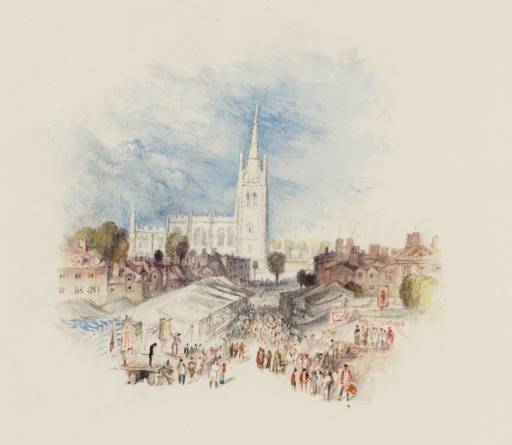Joseph Mallord William Turner A Village-Fair, for Rogers's 'Poems' c.1830-2
Joseph Mallord William Turner,
A Village-Fair, for Rogers's 'Poems'
c.1830-2
Joseph Mallord William Turner 1775–1851
A Village-Fair, for Rogers’s ‘Poems’ circa 1830–2
D27717
Turner Bequest CCLXXX 200
Turner Bequest CCLXXX 200
Pencil and watercolour, approximately 115 x 123 mm on white wove paper, 269 x 309 mm
Inscribed in pencil by the artist ‘Avenues of booths up the wide street or road thro a village – signs here & there | A Conjuror’s or Quack doctor’s booth’ and ‘A Players stage’ along bottom
Stamped in black ‘CCLXXX 200’ bottom right
Inscribed in pencil by the artist ‘Avenues of booths up the wide street or road thro a village – signs here & there | A Conjuror’s or Quack doctor’s booth’ and ‘A Players stage’ along bottom
Stamped in black ‘CCLXXX 200’ bottom right
Accepted by the nation as part of the Turner Bequest 1856
Exhibition history
1904
National Gallery, London, various dates to at least 1904 (398).
1937
Display of Watercolours from the Turner Bequest, [Loan Series A and C], Towner Art Gallery, Eastbourne, January–March 1937 (no catalogue but numbered 8).
1946
Loan of Turner Watercolours from the Turner Bequest [Loan Series A and C], Graves Art Gallery, Sheffield, September 1946–February 1947 (no catalogue but numbered 8).
1953
J.M.W. Turner R.A. 1775–1851: Pictures from Public and Private Collections in Great Britain, Whitechapel Art Gallery, London, February–March 1953 (171).
1975
Turner in the British Museum: Drawings and Watercolours, British Museum, London, May 1975–February 1976 (179).
References
1903
E.T. Cook and Alexander Wedderburn (eds.), Library Edition: The Works of John Ruskin: Volume I: Early Prose Writings 1834–1843, London 1903, pp.233, 244.
1904
E.T. Cook and Alexander Wedderburn (eds.), Library Edition: The Works of John Ruskin: Volume XIII: Turner: The Harbours of England; Catalogues and Notes, London 1904, pp.380–1.
1906
E.T. Cook and Alexander Wedderburn (eds.), Library Edition: The Works of John Ruskin: Volume XXI: The Ruskin Art Collection at Oxford, London 1906, p.214.
1909
A.J. Finberg, A Complete Inventory of the Drawings in the Turner Bequest, London 1909, vol.II, p.904, as ‘The English fair’.
1966
Adele Holcomb, ‘J.M.W. Turner’s Illustrations to the Poets’, unpublished Ph.D thesis, University of California, Los Angeles 1966, pp.80, 81, 82, 86, 99, reproduced fig.38.
1979
Andrew Wilton, The Life and Work of J.M.W. Turner, Fribourg 1979, p.441 no.1186, reproduced.
1953
Bryan Robertson and Sir John Rothenstein, J.M.W. Turner R.A. 1775–1851: An Exhibition of Pictures from Public and Private Collections in Great Britain, exhibition catalogue, Whitechapel Art Gallery, London 1953, p.26 no.171.
1975
Andrew Wilton, Turner in the British Museum: Drawings and Watercolours, exhibition catalogue, British Museum, London 1975, pp.12, 20, 26, 112 no.179.
1993
Jan Piggott, Turner’s Vignettes, exhibition catalogue, Tate Gallery, London 1993, p.97.
The vignette, A Village-Fair, was published in the 1834 edition of Rogers’s Poems, as an illustration to a poem entitled ‘Human Life’.1 The engraver was Edward Goodall.2 The image complements the following lines from Rogers’s poem which Turner marked with a pencil box in the margin of his own copy of the 1827 edition of Poems (see Tate D36330; Turner Bequest CCCLXVI p.93):
A Wake – the booths whitening the village-green,
Where Punch and Scaramouch aloft are seen;
Sign beyond sign in close array unfurled,
Picturing at large the wonders of the world
(Poems, p.84)
Where Punch and Scaramouch aloft are seen;
Sign beyond sign in close array unfurled,
Picturing at large the wonders of the world
(Poems, p.84)
Turner’s vignette shows the lively bustle of a large village fair. In the foreground, several performers compete for the attention of the teeming crowd. This is one of a number of vignettes in Poems to show landmarks or quotidian scenes that would have been familiar and appealing to British audiences. As Andrew Wilton has observed, the church with the buttressed steeple and pointed spire resembles that of St James’s church in Louth, Lincolnshire and the scene bears some similarity to Turner’s watercolour, The Horse Fair, Louth circa 1827 (British Museum),3 engraved for the topographical series Picturesque Views in England and Wales.4
The background details of the composition bear some similarity to those in a preliminary sketch for a vignette, supposedly related to An Old Manor-House (see Tate D27532; Turner Bequest CCLXXX 15). In particular, the spire of the church, the line of regularly spaced trees and the double towers of a building half-seen in the distance broadly resemble those of the study.
The artist’s inscribed instructions beneath the work are intended to clarify certain details of the drawing for the engraver. Turner has indicated that he wanted the final print to clearly show the avenues of booths, the advertising signs and the temporary wooden stages with their itinerant performers. There is also a small pencil sketch of the player’s stage in the bottom right corner of the sheet.
Verso:
Inscribed by unknown hands in pencil ‘17’ top centre and ’30 | a’ centre and ‘CCLXXX 200’ bottom centre
Stamped in black ‘CCLXXX 200’ lower centre
Inscribed by unknown hands in pencil ‘17’ top centre and ’30 | a’ centre and ‘CCLXXX 200’ bottom centre
Stamped in black ‘CCLXXX 200’ lower centre
Meredith Gamer
August 2006
How to cite
Meredith Gamer, ‘A Village-Fair, for Rogers’s ‘Poems’ c.1830–2 by Joseph Mallord William Turner’, catalogue entry, August 2006, in David Blayney Brown (ed.), J.M.W. Turner: Sketchbooks, Drawings and Watercolours, Tate Research Publication, December 2012, https://www

